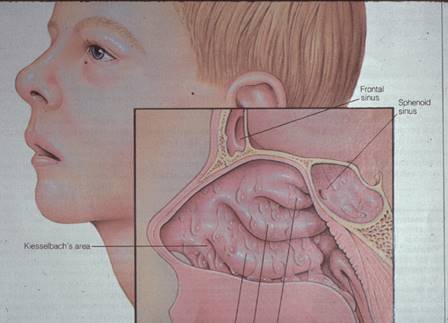Nasal and eye allergies, medically known as allergic rhinitis (AR) or allergic rhinoconjunctivitis, when the eyes are involved is also commonly known as “Hay Fever.” It is not always due to hay, and is “fever” in the old English meaning of the word “fever”, a reaction rather than an increase in temperature. AR (as I will call it) is an allergic inflammation of the nose and eyes caused by allergic reactions to environmental allergens such as pollen, pet hair, dust, or mold. Symptoms include nasal congestion, runny nose with clear mucus, itch of palate, sneezing, red, itchy, and watery eyes, and swelling around the eyes.

In the above diagram, which is from an old Schering presentation, one sees a child who has discoloration and swelling under the eyes (“allergic shiners”), is breathing with his mouth open, and who has lots of clear mucus draining from the “turbinates” (natural ridges) in the nose.
It is important to distinguish “allergies” from a “cold.” The latter usually lasts a week, but AR can last for months. Sometimes it is seasonal and sometimes specific triggers such as a cat or a dog can be suspected. Treatment is first with over-the-counter antihistamines, e.g., Claritin®, Allergra®, or Zyrtec® or with nasal Steroids such as Nasacort®, and Flonase®.
If symptoms persist, or you have concurrent asthma, nasal polyps, sinus infections, or repeated bronchial infections, then a visit to an allergist is necessary. He/she will do a careful evaluation with history, physical exam, pulmonary function testing, and skin tests if necessary, which are sometimes more sensitive than blood tests are often very helpful in finding out what is causing your AR.
Avoidance, in some instances, such as removal of pets and house dust control, sometimes make a huge difference in alleviating symptoms. If necessary allergy shots, also known as immunotherapy, may be necessary. This is a series of shots with increasing doses over 3-5 months, which builds up your immunity against the offending allergens such as pollens, cats, dogs, and dust mites. Shots are often continued monthly for 3-5 years, and may lead to a cure.